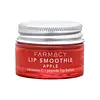What's inside
What's inside
 Key Ingredients
Key Ingredients

 Benefits
Benefits

 Concerns
Concerns

 Ingredients Side-by-side
Ingredients Side-by-side

Hydrogenated Polyisobutene
EmollientDiisostearyl Malate
EmollientPhytosteryl/Isostearyl/Cetyl/Stearyl/Behenyl Dimer Dilinoleate
Skin ConditioningCaprylic/Capric Triglyceride
MaskingPolybutene
Mangifera Indica Seed Butter
Skin ConditioningSynthetic Wax
AbrasiveEthylene/Propylene/Styrene Copolymer
Euphorbia Cerifera Wax
Brassica Campestris/Aleurites Fordi Oil Copolymer
Skin ConditioningButyrospermum Parkii Butter
Skin ConditioningTetrahexyldecyl Ascorbate
AntioxidantPalmitoyl Tripeptide-1
Skin ConditioningPyrus Malus Fruit Extract
Skin ConditioningGlycerin
HumectantMoringa Oleifera Seed Oil
EmollientCurcuma Longa Leaf Extract
Skin ConditioningSolanum Melongena Fruit Extract
Skin ConditioningCoccinia Indica Fruit Extract
Skin ConditioningOcimum Sanctum Leaf Extract
Skin ConditioningCorallina Officinalis Extract
Skin ConditioningMelia Azadirachta Leaf Extract
Skin ConditioningMelia Azadirachta Flower Extract
Skin ConditioningMelia Azadirachta Extract
Skin ConditioningTocopherol
AntioxidantTribehenin
EmollientEthylhexyl Palmitate
EmollientGlyceryl Caprylate
EmollientMalic Acid
BufferingLactic Acid
BufferingSorbitan Isostearate
EmulsifyingAmber Powder
Pentaerythrityl Tetra-Di-T-Butyl Hydroxyhydrocinnamate
AntioxidantButylene/Ethylene/Styrene Copolymer
Aroma
Limonene
PerfumingHydrogenated Polyisobutene, Diisostearyl Malate, Phytosteryl/Isostearyl/Cetyl/Stearyl/Behenyl Dimer Dilinoleate, Caprylic/Capric Triglyceride, Polybutene, Mangifera Indica Seed Butter, Synthetic Wax, Ethylene/Propylene/Styrene Copolymer, Euphorbia Cerifera Wax, Brassica Campestris/Aleurites Fordi Oil Copolymer, Butyrospermum Parkii Butter, Tetrahexyldecyl Ascorbate, Palmitoyl Tripeptide-1, Pyrus Malus Fruit Extract, Glycerin, Moringa Oleifera Seed Oil, Curcuma Longa Leaf Extract, Solanum Melongena Fruit Extract, Coccinia Indica Fruit Extract, Ocimum Sanctum Leaf Extract, Corallina Officinalis Extract, Melia Azadirachta Leaf Extract, Melia Azadirachta Flower Extract, Melia Azadirachta Extract, Tocopherol, Tribehenin, Ethylhexyl Palmitate, Glyceryl Caprylate, Malic Acid, Lactic Acid, Sorbitan Isostearate, Amber Powder, Pentaerythrityl Tetra-Di-T-Butyl Hydroxyhydrocinnamate, Butylene/Ethylene/Styrene Copolymer, Aroma, Limonene
Ricinus Communis Seed Oil
MaskingEuphorbia Cerifera Cera
AstringentSimmondsia Chinensis Seed Oil
EmollientLimnanthes Alba Seed Oil
Skin ConditioningOctyldodecanol
EmollientCetyl Lactate
EmollientSucrose Hexaisostearate
EmollientDiisostearyl Malate
EmollientGlycol Distearate
EmollientOrange Roughy Oil
Skin ConditioningParaffin
PerfumingOlea Europaea Fruit Oil
MaskingTocotrienols
Skin ConditioningSqualene
EmollientBeeswax
Emulsion StabilisingLanolin
EmollientTocopherol
AntioxidantPlacental Extract
Ascorbyl Tetraisopalmitate
AntioxidantIsostearoyl Hydrolyzed Collagen
CleansingPalmitoyl Tripeptide-1
Skin ConditioningPortulaca Grandiflora Extract
Skin ConditioningPalmitoyl Tripeptide-38
Skin ConditioningSucrose Cocoate
EmulsifyingHydrogenated Palm Oil
EmollientLanolin Acid
CleansingHema Trimellitate Anhydride
Triethylamine
Emulsion StabilisingIsostearic Acid
CleansingEthyl Stearate
EmollientSorbitan Isostearate
EmulsifyingStearic Acid
CleansingPalmitic Acid
EmollientTribehenin
EmollientPhenoxyethanol
PreservativeTitanium Dioxide
Cosmetic ColorantCI 45380
Cosmetic ColorantCI 15985
Cosmetic ColorantBlue 1 Lake
Cosmetic ColorantRicinus Communis Seed Oil, Euphorbia Cerifera Cera, Simmondsia Chinensis Seed Oil, Limnanthes Alba Seed Oil, Octyldodecanol, Cetyl Lactate, Sucrose Hexaisostearate, Diisostearyl Malate, Glycol Distearate, Orange Roughy Oil, Paraffin, Olea Europaea Fruit Oil, Tocotrienols, Squalene, Beeswax, Lanolin, Tocopherol, Placental Extract, Ascorbyl Tetraisopalmitate, Isostearoyl Hydrolyzed Collagen, Palmitoyl Tripeptide-1, Portulaca Grandiflora Extract, Palmitoyl Tripeptide-38, Sucrose Cocoate, Hydrogenated Palm Oil, Lanolin Acid, Hema Trimellitate Anhydride, Triethylamine, Isostearic Acid, Ethyl Stearate, Sorbitan Isostearate, Stearic Acid, Palmitic Acid, Tribehenin, Phenoxyethanol, Titanium Dioxide, CI 45380, CI 15985, Blue 1 Lake
 Reviews
Reviews

Alternatives
Ingredients Explained
These ingredients are found in both products.
Ingredients higher up in an ingredient list are typically present in a larger amount.
Diisostearyl Malate is an emollient and most often used in lip products. It comes from isostearyl alcohol, a fatty acid, and malic acid, an AHA.
As an emollient, Diisostearyl Malate helps create a thin film on your skin to trap moisture in. This helps keep your skin soft and smooth.
Palmitoyl Tripeptide-1 is also known as pal-GHK. It is made up of 3 amino acids and palmitic acid, a fatty acid that helps it absorb into skin more easily.
This peptide is as a signal peptide, meaning it tells the skin to produce more collagen. Collagen is the key protein that helps form the skin's structure and keep it plump, firm, and hydrated.
By boosting collagen production, this ingredient supports a stronger skin barrier and helps reduce the appearance of wrinkles.
You'll most likely see this ingredient paired with Palmitoyl Tetrapeptide-7 in the well-known Matrixyl 3000 complex. While results from in-house testing should be viewed cautiously, this peptide duo is among the most studied and widely used in modern skincare.
Due to its palmitic acid base, this ingredient may not be safe for Malassezia folliculitis.
Read more about other common types of peptides here:
Learn more about Palmitoyl Tripeptide-1Sorbitan Isostearate is an emulsifer and cleaning agent. It is created from isostearic acid and sorbitol.
As an emulsifier, Sorbitan Isostearate prevents oils and water from separating.
Due to its isostearic acid base, it may not be safe for Malassezia or fungal acne.
Learn more about Sorbitan IsostearateTocopherol (also known as Vitamin E) is a common antioxidant used to help protect the skin from free-radicals and strengthen the skin barrier. It's also fat soluble - this means our skin is great at absorbing it.
Vitamin E also helps keep your natural skin lipids healthy. Your lipid skin barrier naturally consists of lipids, ceramides, and fatty acids. Vitamin E offers extra protection for your skin’s lipid barrier, keeping your skin healthy and nourished.
Another benefit is a bit of UV protection. Vitamin E helps reduce the damage caused by UVB rays. (It should not replace your sunscreen). Combining it with Vitamin C can decrease sunburned cells and hyperpigmentation after UV exposure.
You might have noticed Vitamin E + C often paired together. This is because it is great at stabilizing Vitamin C. Using the two together helps increase the effectiveness of both ingredients.
There are often claims that Vitamin E can reduce/prevent scarring, but these claims haven't been confirmed by scientific research.
Learn more about TocopherolTribehenin comes from glycerin and behenic acid.
It is used as an emollient, or moisturizer. Emollients form a thin barrier on skin to prevent moisture from escaping.
This ingredient may not be Malassezia folliculitis, or fungal-acne safe.
Learn more about Tribehenin